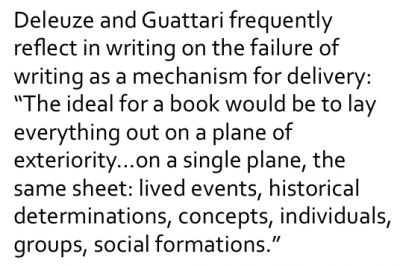 Sometimes my students will tell me I talk too fast. And they’re not wrong. Blame coffee, nerves, my many years spent in New Jersey and New York, or just my usual state of edgy excitement. For whatever reason, I get a high word per minute count when I am teaching. I can promise to try speaking with more measured, spondaic, or prosed deliberation. And yet—and there’s always an “and yet”—there’s something worth considering about the many ways we try to cheat the careful cadence of prepared discourse. In speaking, we often look for ways to thwart the simple left-to-right, top-to-bottom linearity of writing. In simple terms, I think we are looking for ways to say many things at once.
Sometimes my students will tell me I talk too fast. And they’re not wrong. Blame coffee, nerves, my many years spent in New Jersey and New York, or just my usual state of edgy excitement. For whatever reason, I get a high word per minute count when I am teaching. I can promise to try speaking with more measured, spondaic, or prosed deliberation. And yet—and there’s always an “and yet”—there’s something worth considering about the many ways we try to cheat the careful cadence of prepared discourse. In speaking, we often look for ways to thwart the simple left-to-right, top-to-bottom linearity of writing. In simple terms, I think we are looking for ways to say many things at once.
If I’m feeling grandiose, I will compare this to John Coltrane’s “sheets of sound” phase, where he would play as rapidly as he could to suggest chords that, as a saxophonist, he could only arrive at in series, one note at a time. Play these notes fast enough, and they sound like chords.
Stylistically, there are lots of things we can do to play “chords” with our language. I am a big user of the long series of related elements that forestalls closure with conjunctions, commas, em dashes—like this one—, shifts of gear, perhaps taking a moment to remind of the “and yet” in the paragraph above, parentheses (I will sometimes use brackets, too), and whatever else to prevent the sentence from ending; semi-colons can keep the momentum going as well. I want to allow for options and variations in response, and I can’t know what an interlocutor or auditor will choose to take up. Would you like me to call this prose: juiced, like Proust, or At the Royal Roost? Maybe one of these references will work for you, so I’ll include them all.

In written academic discourse, we have footnotes, quotations, winking allusion, direct reference, and all kinds of signposts and gestures for helping a reader choose paths other than the one spelled out by the linear progress of the text’s consecutive sentences. Likewise, the more literary uses of the essay, characterized by digression and the observation/collection of heterogeneous materials, are experiments in saying many things at once. Sometimes, even, an unexpected second section will emerge to mark a shift.
2.
I started this chain of thinking because I have been watching student presentations and noticing that even the best prepared, thoughtful, and productive of presentations often leave other students looking beleaguered and grumpy. What I noticed was an impatience with linearity, a desire to paddle more quickly down whatever prepared river of discourse the presenter was offering. I’m reminded of a surprising conversation I witnessed (via Twitter) about how “no one” listens to podcasts in normal speed now, preferring 1.5x or 2x speeds to better take in the information of these podcasts (many of which in this case were essentially academic lectures). My class watched a Vox video recently that had a similarly amped up audio track. Hyperspeed, manipulated audio is all around us, and I suppose my question is how writing (or even talking) will keep pace. Does even a seminar conversation feel like slow-motion to students raised in a post-talk world?
We can and we should experiment with design and typographical elements to suggest speed and plurality (like this amazing Futurist book). And we’ve got to keep talking about plain, old writing as a still workable technology. But my interest at this point is with sound’s capacity for conveying layered, multiple, flows of information.
In the next few months, I’ll be working on a project that explores elements of creativity and composition through a musical/pedagogical partnership I’ve been developing. That is [he writes, attempting a second pass at similar information], I want to provide forums for experiments with sound, music, and composition that are simpatico with our ongoing FYW work. I’m sure to ask for collaborators soon enough, and I hope to run the Fall 2019 or Spring 2020 conference around this topic. In the meantime, let’s keep talking (rapidly, at the same time) about what’s possible.
***I didn’t really work a reference into this post, but I should mention this remarkable book that has been a support for some of my recent thinking about sound and writing pedagogy. Take a look or listen when you get a chance. You can even download chapters in podcast form so you can listen to them at 2.0 speed.